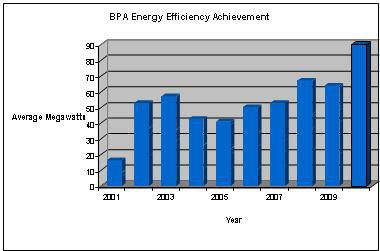forum
library
tutorial
contact

Bonneville Power Releases
$35M for Efficiency Programs
by Christina Williams
Sustainable Business Oregon, June 15, 2011
|
the film forum library tutorial contact |

|
Bonneville Power Releases
by Christina Williams
|
 The Bonneville Power Administration announced Wednesday it will dedicate $35 million this year to public utility energy efficiency programs. The money was scheduled to be delivered over the coming years.
The Bonneville Power Administration announced Wednesday it will dedicate $35 million this year to public utility energy efficiency programs. The money was scheduled to be delivered over the coming years.
The BPA released a statement saying that public utilities in the Northwest broke a new energy efficiency record last year, freeing up enough electricity to power 65,700 homes.
The Northwest already leads the nation in energy efficiency, supplying 12 percent of its electricity needs in 2009 through energy savings compared to just 1 percent for the United States overall. The funding for efficiency coming from BPA is aimed at helping utilities add to that lead -- sooner rather than later.
"Energy efficiency makes great sense for the Northwest and for the consumer's bottom line," said Scott Corwin, executive director of the Public Power Council, in a press release. "We already have one of the cleanest energy supplies in the nation, and, the more electricity we can save, the farther that will take us. The timing of this additional funding is an indication of the ambitious pursuit of energy efficiency programs by public power utilities."
The BPA is under fire from renewable energy companies that are mounting legal challenges to its policy to power down wind farms during times of power oversupply.
bluefish received the following group email from BPA's Steve Weiss, Constituent Account Executive for Public Interest GroupsI want to clarify an aspect of the press release below based on feedback I am receiving. As some of you may have heard in other forums and discussed in the press release, the $35 million is not new funding. Instead it is money being moved forward from future years. Much of this money is being used for low-cost measures such as lighting-measures that have costs quite a bit below BPA's projected average energy efficiency (EE) costs. Thus Bonneville believes that this $35 million will achieve savings that had been projected, when budgets were originally proposed, to cost about $47 million. What is technically happening is that we can get more aMW this year (FY11) than we originally expected (holding all other things constant - including an amount assumed for utility self-funding based on about 25% of the target). The average cost that we assumed for this year on a $/aMW basis is lower than it is in the next three years, by $12m ($47m - $35m).
Therefore BPA will likely propose in future Integrated Program Review (IPR) decisions to reduce its out-year EE budget by up to $47 million, not $35 million. (The IPR is the public process BPA conducts in the period before each two-year rate case to set program budget levels.) At this time, that future budget has not been subject to that public review, so it is not set in stone. It is important to note that the ultimate controlling factor for the EE budget floor is having enough funding to meet the public utilities' share of the Council's targets. At issue may be whether BPA should go beyond that target if savings are coming in at a lower cost than expected.
learn more on topics covered in the film
see the video
read the script
learn the songs
discussion forum
